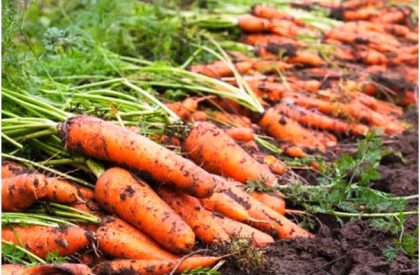Carrot Cultivation Guide


Carrot is a winter season crop and if grown at 15°C to 20°C will develop a very good colour. Carrot crop needs deep loose loamy soil and pH should be ranging from 6.0 to 7.0 for higher production. You can easily grow this healthy vegetable in your kitchen garden, all you need is a little guidance as to when and how to grow it.
Carrot Cultivation
Growing Season
Hills: In hilly areas at elevation above 1500 metres, under assured irrigation carrot can be grown throughout the year but at elevations between 1000 – 1500 metres, Carrot can be grown between July – February.
Plains: In plains carrot is grown in the month of August.
Seed rate
Seed rate is : 4 kg/ha
Spacing
Rows are marked with spacing of 25 – 30 cm apart. Sow the seeds mixed with sand and it should be one part of seed with 4 parts of sand.
Thinning
Hills: Between plants it should be 10cm
Plains: Between plants it should be 5cm
Preparation of field
Hills: The field should be prepared to a fine tilth and form raised beds of 15 cm height, one metre breadth and convenient length.
Plains: Two ploughings are given and ridges and furrows are made at 30 cm spacing.
Carrot Seed treatment
Seed treatment with cow pat, pit at rate of 3 g in 1 litre of water for 24 hours.
Seed treatment with 5% Trichoderma viride.
Before transplanting, seedling root dip with 5% Pseudomonas fluorescens.
Irrigation
Once in five days, irrigation should be given. During drought period, to prevent excessive water loss during sunny days and to improve germination of the seeds. It should be kept in mind that after giving irrigation in the evening, beds should be covered with wet gunny bags.
How to Grow Better Seedlings:
After selecting the best rhizome. Next, place them aside for several days to enable the split surface region to recover and grow a callus.
Ginger grows gradually, particularly outside. If you are a complete beginner to ginger farming, we will suggest you be patient. However, the sprout might arise within several days if you’re fortunate.
Continue to water for at least a two weeks. Keep hoping…
Do not place the bed under direct sun. A movable tray bed is recommended. In this stage, it needs 3-4 hour of sunlight in the morning and evening. Naturally, one acre of land needs 600 – 800 kg of seed-ginger to sow.
Progressive banana varieties
In local languages, this banana is known as Bhusavali, Basrai, Marisas, Kabuli, Sindurani etc.
It is very popular in India.
Its plant is small, while the fruits are large.
Its pulp appears soft and sweet in food.
This variety is also known as Bambegreen and Harichal.
The areas of the Western Deep Group are famous mainly for its cultivation.
The banana plants can be 3 to 4 meters in height.
While their stem is medium thick and thick green.
Green fruits develop in them.
On an average, each bunch weighs between 25 and 30.
Fruits are yellow.
Customer Feedback
Talented Agronomist
Team Alexa made my Poly-House very well & also helped by assisting in organic Framing. Thanks & All the Best for the future.
Ms. Poonam Saxena, Indore (M.P.)
landownerExcellent job, excellent workmanship
Currently, Team Alexa helping me on Orchid Cultivation in Poly house. I’ve have to say till now everything is good and expecting the same for future.
Mr. Rajendra singh , Indore (M.P.)
landownerGreat ! Work
I would suggest Alexa Farms for Poly house Farming , Hi Tech Farming Organic Farming because there professionals have knowledge for all the crops.
Mahant Dharmendra Puri, Indore
landownerDone Wonderful job
Amazing design and installation of our new, beautiful yard. Gardener is professional, creative and knowledgeable designer.
Mark Angelino
NewyorkPlanting & Removal Charges
Within a your budget you can freshen up your plant with a few key upgrades that will increase your home’s curb appeal. A new gravel driveway or concrete walkway can make your home look like new. Small budgets are good for breaking up a larger project into manageable chunks, so you might splurge for a nice walkway this year and deal with the driveway later.

